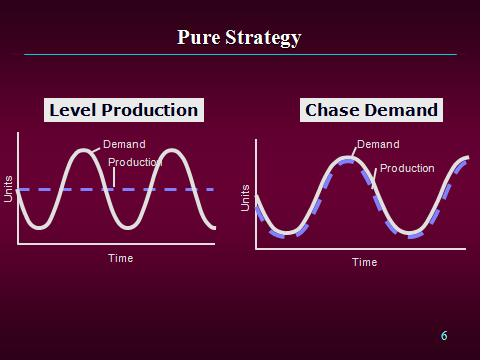Aggregate Planning
Aggregate Planning, also often part of the Sales & Operations Planning (S&OP) process, operates at an intermediate time horizon (typically 3 to 18 months). Its primary goal is to determine the optimal combination of production rate, workforce level, and inventory on hand for product families (groups of similar products) to meet forecasted demand while minimizing overall costs.
Key Characteristics:
- Aggregation: Planning is done for broad product families or groups, not individual items (e.g., planning total number of sedans, not specific models/colors). Resources (capacity, labor) are also considered in aggregate terms.
- Time Horizon: Intermediate range, allowing adjustments to workforce levels and inventory, but assuming fixed facility capacity.
-
Objective: Balance supply (production capacity) and demand (forecasts) cost-effectively over the planning horizon. Minimize total costs related to:
- Regular Payroll
- Overtime / Undertime
- Hiring / Layoffs
- Inventory Holding
- Backorders / Lost Sales
- Subcontracting
Inputs:
- Demand forecast for each period in the planning horizon (aggregated by product family).
- Available capacity (regular time, overtime possibilities).
- Current workforce level and productivity rates.
- Beginning inventory level.
- Relevant cost data (as listed above).
- Company policies (e.g., regarding workforce stability, inventory levels, backorders).
Outputs:
- Planned production rate for each period (regular time, overtime, subcontracting).
- Planned workforce level for each period (including hiring/firing).
- Projected inventory level or backorder quantity for each period.
- Total estimated costs for the plan.
Basic Aggregate Planning Strategies:
Organizations typically use a mix, but understanding the pure strategies is helpful:
-
Chase Strategy:
- Approach: Match the production rate exactly to demand in each period. Absorb fluctuations by varying the workforce (hiring/firing) or by using overtime, idle time, or subcontracting.
- Pros: Low inventory levels and costs.
- Cons: High costs associated with changing workforce levels (hiring, training, severance), potential morale issues, potential strain on operations during peak hiring/overtime.
-
Level Strategy:
- Approach: Maintain a stable workforce and a constant production rate throughout the planning horizon. Absorb demand fluctuations through inventory build-up, planned backorders, or potentially lost sales.
- Pros: Stable workforce morale and output rates, easier planning.
- Cons: Can lead to high inventory holding costs during low demand periods or high backorder/lost sales costs during peak demand periods. Requires accurate forecasting.
Practical Problem Approaches (Simplified):
- Level Strategy: Calculate total demand, determine average required production rate, set a constant workforce, calculate period-by-period inventory/backorders.
- Chase Strategy: Set production equal to demand each period, calculate the workforce/overtime/subcontracting needed, calculate associated costs (payroll, hiring/firing, overtime premiums, etc.).
Indian Example: An Indian air conditioner manufacturer like Voltas or Blue Star faces highly seasonal demand (peak in summer). Their aggregate plan must address this. A likely mixed strategy involves:
- Maintaining a core level workforce and producing at a steady rate during off-season months to build some inventory.
- Using chase elements like hiring temporary workers, scheduling significant overtime, and potentially subcontracting some components during the pre-summer and peak summer months to meet the surge in demand without excessive inventory buildup.
Aggregate planning provides the crucial link between the long-term business plan and the short-term Master Production Schedule, setting the overall operational parameters for the medium term.


No Comments